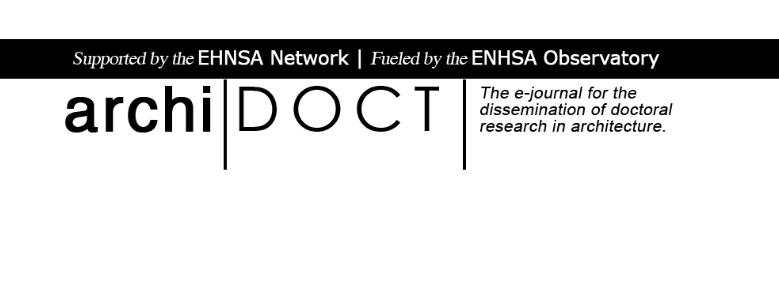The 14th issue of ArchiDOCT invites doctoral students and researchers to submit essays that examine the notion of “Meta-” and the way this radical but subtle paradigm shift creates novel possibilities, but, also, demanding challenges for architecture.
The 14th issue of the ArchiDoct e-journal addresses the notion of “meta”, a term typically used to denote something of a higher or second-order; or a change of position or condition; or a position behind, after or beyond.
“Meta” in Greek is an extremely wide-ranging word, used to denote, among others, the way in which, in accordance to, after, in-between, with. We use the term “meta” to define our current condition, of a higher or second-order, one that comes after and goes beyond but also with the one that came before and more importantly, describe the intermediate, betwixt, in-between nature of our times.
Our Meta- age is difficult to define as many separate conditions of the past coexist and are blended and merged together in a new, hybrid and fused reality. The pre-modern, pre-industrial, pre-alphabetic world, reigned by handicraft, orality, immersion, randomness, aggregation, nowness and emotion and the modern, industrial, alphabetic world, ruled by machine-made, text, theory, regulation, analysis, perspective and rationality; are now merged in this meta- condition, where new hybrids are conceived and engendered and a new and programmed wilderness emerges.
Relation and mediation characterizes this meta- age and architecture as a formerly principal mediator is challenged. The Meta- issue aims to examine this challenge in different aspects of architecture.
Design as a detached and separate process from construction is reconsidered; typologies and customization are re-examined; representations no more aim to describe buildings or objects but rather to relate the experiences of subjects in or with them; unbuilt simulations become autonomous and even more seductive than the experience of physical space; materials are no longer classified as natural, artificial or industrial as they are all calculable or even programmed; description of forms surrenders to the survey of in-formation through abstract modeling conceptions; subject and object opposition becomes irrelevant as interconnected subjects and re-contextualized things that form part of an almost animated standing reserve, define new possibilities for novel interrelations and configure dynamic atmospheres.
The 14th issue of ArchiDOCT invites doctoral students and researchers to submit essays that examine the notion of “Meta-” and the way this radical but subtle paradigm shift creates novel possibilities, but, also, demanding challenges for architecture.
Guest editor: Dr. Polyxeni Mantzou, Pr. Department of Architectural Engineering, Democritus University of Thrace, Greece.
Submission Date: September 15, 2019

Submission Policy
Archidoct is published two times a year, in July and February. The official language of the journal is English. Submitted manuscripts for review should not exceed 4500 words, including abstracts, references and image captions. The referring system will be the Harvard System. Text should be saved in a Microsoft Word or RTF file, while the supporting visual material (images, diagrams, sketches, tables and so on) should be sent as TIFF files with a resolution of at least 300 dpi. All visual material should be clearly indicated and numbered in the text, along with the respective image captions and credits. Additionally, all manuscripts should be submitted in A4 ”camera-ready” .pdf format that gives an idea of what a finalized version looks like.
Archidoct only accepts manuscripts from PhD students. In order for an article submission to be considered for publication, the student must be a registered and active member of the ENHSA Observatory (www.enhsa.net/main/observatory), a PhD research portal created to facilitate communication and meaningful information exchange between architecture doctoral students.
Reviewing Policy
The peer reviewers are all confirmed educators of architecture coming from different educational backgrounds, with different specialisations and expertise that share the common interest of their doctoral students: to encourage them to publish their work while improving their thinking processes towards academic research writings. Each submitted article is reviewed by two members of the journal’s Scientific Committee anonymously.
Copyright Policy
The ArchiDoct journal is offered in a downloadable form for academic and research purposes only. All material published in each issue is, unless otherwise stated, the property of the authors of the respective articles. The reproduction of an article in whole is only allowed with the written consent of the author. Any reproduction of the material in parts, in any manner, should properly credit the copyright holder. A single copy of the materials available in each issue may be made for personal, noncommercial use.
For all enquiries, requests and contributions please contact: [email protected] / [email protected]
READ ALSO: Alegria Residential Building | MiMool Arquitectura & Design de Interiores